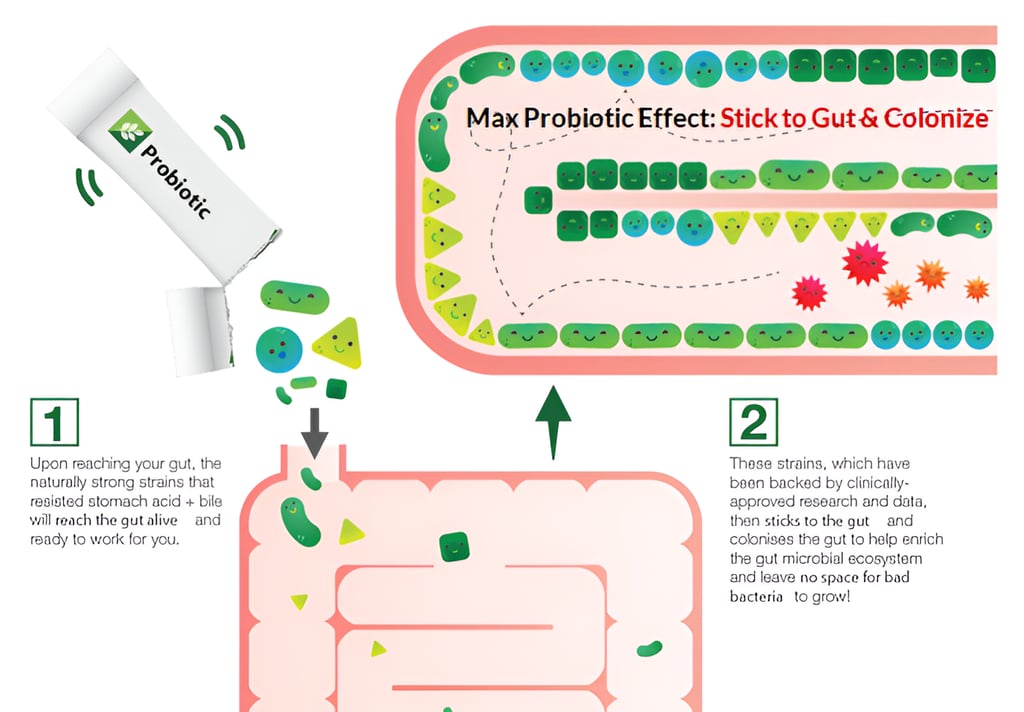

Resetting the Gut
The journey of probiotics begins long before they reach your gut—starting in the lab, they’re carefully cultivated and prepared to help restore balance to the trillions of microorganisms already within you. Known as your “second genome,” this vast microbial network isn’t just a passive presence; it actively influences essential functions like digestion, metabolism, immunity, and even mood. Just as your gut microbes play an active role, your diet and lifestyle choices also shape this ecosystem.
While your gut microbiome has a remarkable capacity to return to balance, or homeostasis, on its own, it can still experience imbalances. Poor lifestyle choices—such as an unhealthy diet, lack of exercise, or chronic stress—can disrupt this delicate balance, leading to a condition known as dysbiosis. Dysbiosis often involves an overgrowth of certain strains and a decline in microbial diversity. In these situations, probiotics can play a vital role in restoring equilibrium by reintroducing beneficial strains.
However, before you jump the gun and start introducing probiotics, it’s important to consider the gentle warning from Dr. Lorenzo Cohen, a professor at the University of Texas MD Anderson Cancer Center: “You can inadvertently create a form of dysbiosis by having too much of a good thing. Overloading on specific strains can crowd out not only harmful bacteria but also essential beneficial strains, ultimately diminishing microbiome diversity.” This underscores the importance of a balanced approach to fostering a healthy gut ecosystem, which you will learn more about.
The Importance of CFU
When selecting a probiotic, it's essential to consider the Colony Forming Units (CFU)—which indicate the number of live, viable bacteria per serving. Generally, higher CFU counts are more effective for survival and impact (with counts below a billion often falling short) to positively influence your gut health.
Key Considerations for CFU:
Minimum Effective Dose: Aim for a probiotic supplement that provides at least 1 billion CFUs per serving. This threshold is often considered the minimum effective dose to ensure enough bacteria reach the gut alive.
Optimal Range: While higher CFU counts can be beneficial, excessively high numbers (such as 50 billion or more) may not offer additional advantages and could potentially cause discomfort. An optimal range is typically between 5 billion and 20 billion CFUs per serving. Even at 30 billion CFUs, some individuals may experience mild side effects like gas, bloating, or nausea.
CFU Count, Not Mg: Ensure that the product label clearly states the CFU count per serving. Be cautious of products that list the total CFUs for the entire bottle, as this can be misleading. Additionally, CFUs should be listed as such, rather than in milligrams (mg), to provide accurate information about the number of viable bacteria.
As you may already realize, a higher CFU count per serving often comes with a higher price tag, stemming from the misconception that more CFUs automatically result in better outcomes. However, you now understand that this belief is NOT accurate! Instead, aim for an optimal CFU range rather than simply the highest count. While CFU count is important, remember, it’s just one piece of the puzzle. Let's read on.
What's a Strain?
Okay, let's break it down: in the world of probiotics, a "strain" is like a specific type or version of a bacterial species. It's kind of like different breeds of dogs within the larger category of "dogs." Each strain has its own unique characteristics and abilities.
For example, take Bifidobacterium lactis HN019. HN019 is a specific strain of the Bifidobacterium lactis species. This strain is not only great at surviving the acidic environment of your stomach, but it also has a fantastic ability to stick to the gut wall. This means it can settle in and start working effectively to support your digestive health.
So, when you see different strains listed on probiotics labels, they're not just random names—they represent different types of bacteria with specific qualities that can help your body in different ways. That said, avoid supplements with more than 10 different strains to keep things balanced and effective. Curious about how HN019 and its hero buddies work together to restore balance to your gut?
Wrapping It Up
The journey of live probiotics from the lab to your gut is a wild ride. Freeze drying technology helps keep the bacteria stable on the shelf at room temperature without the need for refrigeration. But before they reach the shelf, they face a wild rollercoaster ride. Keeping them alive takes careful handling, top-notch packaging, and knowing which strains can handle the trip.
It's a bonus if there's traceability—with production, packaging, and logistics records that detail every step of the good bacteria. But when they make it, these tiny heroes can truly work their magic and keep your digestive system (and all other body systems connected to it) happy and healthy.
Return to:


The Voyage Through Your Body
These beneficial bacteria embark on quite a voyage, starting from the lab and enduring various temperatures, storage, and handling conditions on their way to your home. Along the way, they need protection from moisture and oxygen to stay alive.
Once they reach you, their mission continues. Probiotics must survive the harsh conditions of your stomach, braving strong acids and bile in the small intestine before finally adhering to the gut wall and thriving.
If they don’t successfully stick, they’ll be swept out of your system through peristalsis and end up in your feces. While this may seem straightforward, it simply means that if these friendly bacteria don’t reach their final destination—adherence to your gut and colonization—they haven’t reached their maximum effectiveness.


